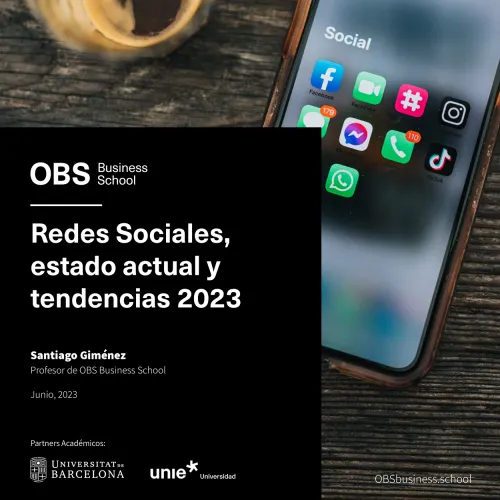
OBS Report: Social Media, current state and trends 2023
Advertising investment in social media already represents 33.9% of total spending in the digital area
- 59.4% of the world's population uses social media. There are 4.76 billion social media users (94.9% of the internet population).
- In 2024, advertising investment in social media will exceed $300 billion.
- Social media accounts for 42% of traffic to e-commerce and 17% of purchases are made through them.
- The incorporation of AI in the sector and the emergence of niche social media for minorities will be key in the future.
- Balancing innovation, responsibility, and user well-being will be crucial in determining the future of the sector."
June 2023. OBS Business School publishes the report Social Media: Current State and Trends 2023, led by Professor Santiago Giménez. Its purpose is to provide a comprehensive and up-to-date view of the world of social media, its impact on different aspects of society such as communication, culture, commerce, and politics; to examine concerns related to privacy, security, misinformation, and cyberbullying; and to explore technological innovations and future trends.
Social media have played a fundamental role in transforming our society, revolutionizing how we communicate, interact, consume information, and engage in social and political issues. However, they have also brought challenges such as the spread of misinformation, polarization of opinions, and invasion of privacy.
Since their inception, there have been mergers among different companies in the sector, raising significant concerns about the dominance and control of data by a few major players. It is a highly competitive and ever-evolving market where continuous innovation is essential to adapt to changing user demands, while new players and emerging trends bring diversity and challenge the status quo. Monetization through advertising remains a key source of revenue, and several social media platforms are now publicly traded (Meta, LinkedIn, Twitter, Snap, Pinterest, YouTube).
The profile of social media users
Approximately 5.16 billion people have internet access, of which 4.76 billion are social media users (94.9% of the internet population). This figure grows annually by 3% and already represents 59.4% of the world's population. Most users are located in Western countries and Asia; Northern Europe has the highest usage (83.6% of internet users), followed by Central and Western Europe at 83.3%, and North America at 73.9%. 53.7% of social media users are men, while 46.3% are women, with the vast majority falling between the ages of 20 and 39.
The average daily time spent on social media is 2 hours and 31 minutes and is clearly increasing, although statistics vary by age and gender: women aged 16-24 lead daily social media usage with an average of 3 hours and 11 minutes per day.
The most used platforms in the world
Facebook remains the most used social platform in the world; however, YouTube is rapidly closing the gap with twice the audience growth (2.51 billion active users). The third most used platform is WhatsApp, followed by Instagram, whose audience has grown by over 35.3% (522 million users). TikTok also has 5.1% more users than last year, a rapid rise driven by its popularity among Millennials and Generation Z. However, this platform is under scrutiny by various states due to the large amount of data it accumulates, which could be a concern in the hands of certain countries. In fact, the Netherlands is restricting its use to certain government employees. Santiago Giménez writes: "It's true that most social networks engage in similar practices, but being Western, there seems to be less concern about how they use data.' TikTok has also faced criticism for its high potential for addiction".
On the other hand, China has blocked Facebook, Instagram, and Twitter. Although not entirely prohibited, access to these platforms is not straightforward. This reflects an economic and political war highlighting the strength and potential of social media today, often used as tools for organizing, mobilizing, and spreading social and political causes, as seen during the Arab Spring or the Me Too movement.
The most important Social Media trends to consider
Social media drives 42% of traffic to e-commerce, with 17% of purchases being made through them. Therefore, the trend is to integrate e-commerce functionalities directly into the platforms, allowing users to buy products without accessing other sites.
Other current trends include ephemeral content publishing, the growing use of video, personalization, and the integration of augmented reality filters. Virtual reality is rapidly advancing and expected to be further integrated into social media, enabling users to immerse themselves in shared virtual environments. However, undoubtedly, the most impactful change shaping social media in the future will be the incorporation of AI, especially for customer service and user interaction. AI systems are expected to autonomously generate content, significantly impacting content production and consumption. Additionally, user engagement and content creation will remain key trends, as platforms will continue to encourage and facilitate the sharing of personal experiences.
Beyond large and established platforms, it is expected that more specialized social networks focused on specific communities will emerge—niche networks catering to particular interests and passions, providing users with a more focused and personalized experience.
Where do social media revenues come from?
Social media generates revenue through advertising, brand collaborations, product and service promotions, and the sale of data. Investment in social media already represents 33.9% of total digital advertising expenditure.
While in 2022 this investment amounted to $226 billion, with a growth of 6.9% (1.78 billion dollars in Spain with a growth of 0.7%), it is projected that global investment will exceed $300 billion USD by 2024, a 33% increase compared to 2022. Social media platforms like Meta dominate the advertising market with a 45% market share.
On the other hand, it's worth noting that in 2022, over $27.51 billion (a 4.6% increase) was spent worldwide on influencer advertising. In Spain, this figure was $271 million, with a 5.1% growth compared to the previous year.
The OBS report anticipates greater regulation and accountability in the world of social media, prioritizing user privacy and security. Balancing innovation, responsibility, and user well-being will be crucial in determining the future path.
Content written by:
Carmen García-Trevijano
OBS Business School's Press Office


